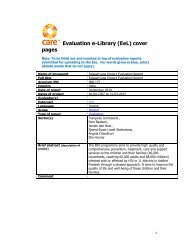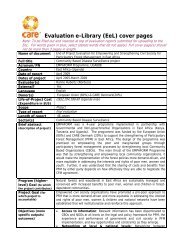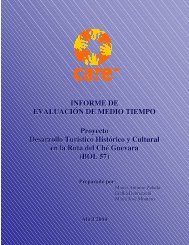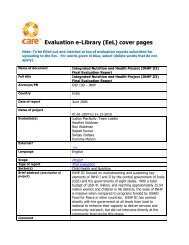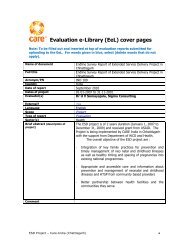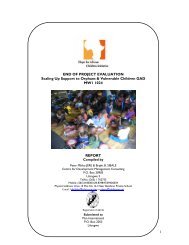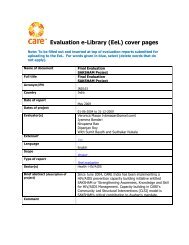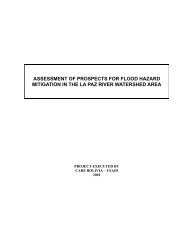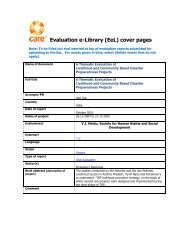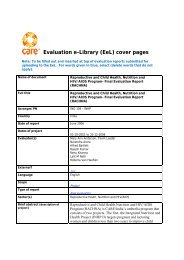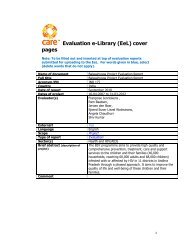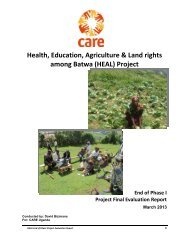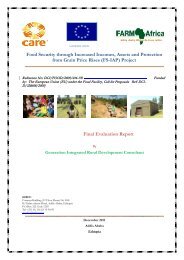IND 199 ECDE Baseline - CARE International's Electronic ...
IND 199 ECDE Baseline - CARE International's Electronic ...
IND 199 ECDE Baseline - CARE International's Electronic ...
- No tags were found...
Create successful ePaper yourself
Turn your PDF publications into a flip-book with our unique Google optimized e-Paper software.
lxivSC ST OBC SC ST OBC SC ST OBC(n=) 102 124 201 92 118 212 145 77 240< 25% 0 2.4 1.5 0 1.7 0.5 1.4 1.3 1.725.1 -50% 8.8 21.8 10.9 12 13.6 10.8 6.2 2.6 550.1 -75% 69.6 58.9 67.7 71.7 71.2 72.6 53.8 62.3 65.4> 75% 21.6 16.9 19.9 16.3 13.6 16 38.6 33.8 27.983 7.2 Children aged 5-5.5 years7.2.1 Profile of children aged 5-5.5 yearsAbout half of children in intervention AWCs, 57 percent in intermediate AWCs and 52 percentin control AWCs were male. More than 95 percent of them belonged to SC/ST or OBC. In mostthe cases (96% in intervention, 98% in intermediate and 92% in control AWCs) , the motherof the child was the respondent. If caregiver was the respondent, they were mostly grandmother of the child. More than 90 percent of children go to AWC. About 56 percent of thechildren in intervention districts and 60 percent in control district were given the schoolreadiness test at the AWC (Table 7.18A in Annexure -2).7.2.2 Scoring on school readinessThe school readiness instrument includes three categories of competencies – pre mathematicalconcept; number concepts and language skills & reading readiness. In school readinessinstrument, a number of pictures were shown to the child indicating activity number ,questions asked under the activity and the possible scores a child could obtain. The details aregiven below:Activity no. Question asked Possible scores1. Three trees numbering A, Band C with some fruits2. Two pictures numbering A andB with a hut and a child3. Four pictures of banananumbering A,B,C and D4. 6 pictures of fruits andvegetables5. Instructions for the child tofollow1.Which fruit do you see ineach of the pictures?2. In which picture you cansee the least number of fruit?3. In which picture you cansee the most number of fruit?1.In which picture is the childat the back of the hut?Describe sequence in wordsIdentifies the sequence only bypointing to the pictures1. Point to each picture andask the child, “what is this?”;“Is it a fruit or vegetable?”2. Then ask the child to showyou/point out all thevegetables and then all thefruits separately.0. for incorrect answer orunable to answer1. for 1 correct answer2. for all the correct answers(maximum )0. for incorrect answer orunable to answer1. for correct answer(maximum)0. for incorrect answer orunable to answer3. If the child is able tocorrectly identify thesequence, only by pointingto the pictures.5. If the child is able todescribe sequence in wordsand correctly (maximum)0. for incorrect answer orunable to identify any fruits/ vegetables correctly4. If the child is able toidentify at least 2 fruits and2 vegetables6. If the child is able toidentify all fruits andvegetables (maximum)0.Unable to follow either ofthese instructions2. If child is able to follow asimple instruction4. If child is able to followseries of instructions.<strong>Baseline</strong> Study Of Early Childhood Care And Development Project In ChattisgarhApril,2012



